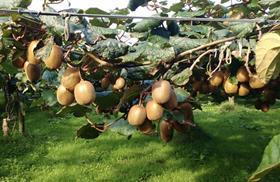
Plant & Food Research’s response to the outbreak of Psa in New Zealand has been recognised with this year’s Prime Minister’s Science Prize.
When the kiwifruit vine-killing disease was first discovered in New Zealand in 2010, Plant & Food Research moved quickly to mobilise a team of more than 100 people, including plant pathologists, breeders and orchard management specialists.
Initially, the Plant & Food Research team worked with the industry to contain the spread of the disease by developing new orchard management techniques. The science team also developed diagnostic tests to inform growers’ management decisions and identified agrichemicals that could protect against the disease.
“Psa was potentially devastating for the New Zealand kiwifruit industry,” said Dr Bruce Campbell, Plant & Food Research’s chief operating officer. “When the disease was discovered, we knew we had limited time to find the solutions the industry needed to manage the disease and remain viable.
“It was an incredibly stressful time for our scientists, not only in terms of how fast the scientific process was having to deliver answers but also the emotional impact the disease was having on their friends and neighbours. I’m incredibly proud of how the Plant & Food Research team responded, and this prize really demonstrates the importance of their work to New Zealand.”
Longer term, it was determined a new gold cultivar would be required to support the ongoing growth of the kiwifruit industry, after Hort16A, marketed globally as ZespriGold, was found to be particularly susceptible to Psa.
A new gold kiwifruit cultivar ‘Zesy002’, referred to by growers as Gold3 and sold around the world as ZespriSunGold, was already in the initial commercialisation phase. After an intensive screening programme of the hundreds of genetically-diverse varieties from the breeding programme, ‘Zesy002’ was discovered to be tolerant to the disease.
“Identifying a new cultivar is complex, as it has to have the right characteristics to meet grower requirements as well as meet consumer demands for taste,” said Campbell.
“Having a cultivar that met these requirements and also had tolerance to Psa was an important step in the industry’s recovery. We screened hundreds of plants to make sure Gold3 was the best option for the industry, we really didn’t want to get that wrong.”
Fast forward to the 2017 season and 48m trays of Zespri SunGold were sold, with an export value of NZ$686m, up 70 per cent on the previous year.
The Prime Minister’s Science Prize includes a NZ$400,000 fund to be used to support the team’s work. Plant & Food research said the money would be used to establish New Zealand as a hub for bioprotection technologies and further the development of new science technologies to protect plants against biosecurity threats.
“This prize will help us to accelerate the strong positioning of New Zealand internationally as the leader in ensuring food security,” Campbell added.






No comments yet